What Workers Want vs. What Employers Offer in 2025
The gap between what employees expect and what employers deliver is more than a misalignment—it’s a structural disconnect shaping the future of work. From flexible hours and remote roles to transparent pay scales and inclusive cultures, workers are voicing priorities that many companies still underestimate. If businesses want to retain talent and remain competitive, it’s time to listen more closely—and act with greater clarity.

The relationship between employers and workers has fundamentally transformed beyond recognition. While COVID-19, digital innovation, and economic pressures have reshaped workplace dynamics, there is still a significant disconnect. Even in 2025, companies struggle to meet workforce demands for remote options, employment stability, equitable compensation, and professional development opportunities. As International Labor Day approaches, Jobseeker's latest analysis examines the current state of employer offerings, highlights critical gaps in meeting employee needs, and provides actionable strategies for organizations to close these divides this year.
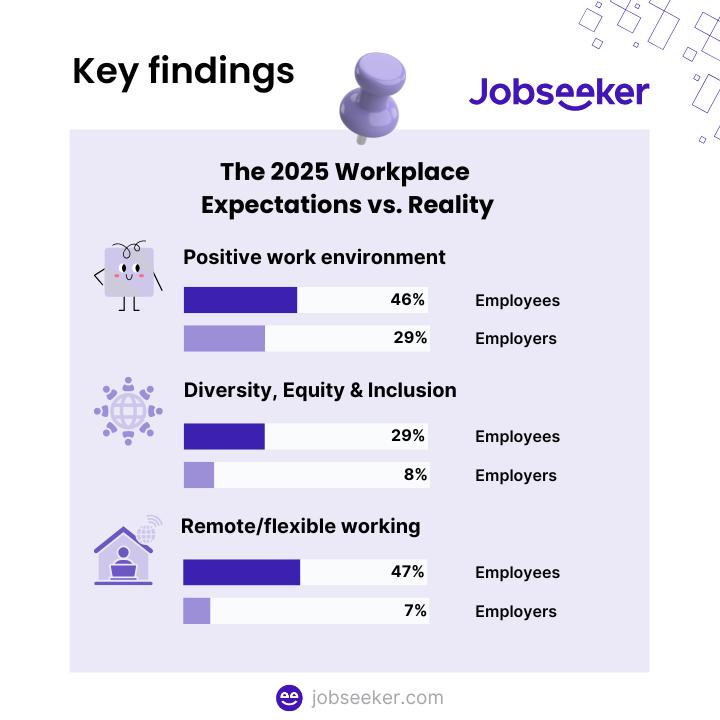
Research methodology
This new study by Jobseeker combines original 2025 survey data, gathered from 350 HR specialists, with secondary data gathered by Jobseeker from employees over the past year. HR specialists were surveyed on a range of workplace hot topics, including job flexibility, salary expectations, AI-related job concerns and retention strategies, with the findings compared to employee opinions on the same subjects. Data was analyzed from three prior Jobseeker employee surveys, focused on job satisfaction, career priorities, and gender-based workplace experiences. As a result, Jobseeker can identify the most pressing mismatches between what workers want and what employers offer, informing business leaders on strategies to close the gap between employee expectations and current employer offers.
Key Findings
The research identified five key mismatches between employee expectations and employer offers in 2025:
- Positive work environment: 46% of employees say it’s a top priority, while only 29% of employers think it’s important to employees.
- Diversity, Equity & Inclusion (DEI): 29% of employees care about it, while only 8% of employers believe employees prioritize it.
- Remote and flexible working: 47% of employees want fully remote working, while only 7% of employers offer it.
- AI pressure: 65% of employees feel pressure to use AI in their work, while only 37% of employers make it a priority in their hiring.
- Job security: The second most-cited reason for employees wishing to change jobs, but only 18% of employers cite job instability as a reason people leave.
Job Satisfaction: What Employees Value vs. Employer Priorities
The key to job satisfaction in 2025 is a varied and diverse picture, with employees placing ever greater value on aspects beyond salary and status. While a competitive salary and benefits are still the key priority, mentioned by 61% of employees, a growing list of other priorities is becoming more prominent. These include:
- Job security: 51%
- Work-life balance: 46%
- Positive work environment/culture: 46%
- Opportunities for career advancement: 40%
- Flexibility (remote work, flexible hours): 31%
- Diversity, Equity, and Inclusion (DEI) initiatives: 29%
- Meaningful/impactful work: 12% (1)
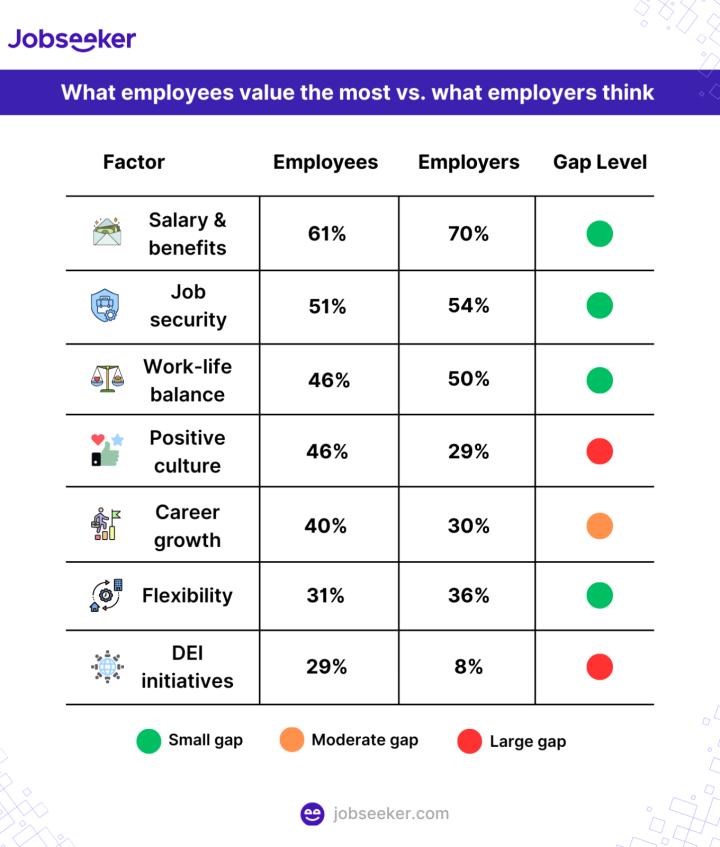
Employers and employees aren’t directly aligned on their opinions of what leads to job satisfaction, with employers over-emphasizing salary and benefits expectations and underestimating employee priorities in other areas:
- More than two-thirds of employers (70%) mentioned ‘competitive salary and benefits’ as one of the key aspects of job satisfaction.
- Employers underestimate the impact of a positive work environment on job satisfaction, with just 29% of employers mentioning it, compared to 46% of workers.
- Less than 1 in 10 employers believed DEI initiatives were a major contributor to job satisfaction, contradicting employee feelings on the subject, with more than 1 in 4 workers valuing it.
- Employers slightly underestimate the value employees place on career advancement opportunities (30% vs. 40%).
These misalignments in the employer beliefs around what contributes to work-life balance, and what employees prioritize, could have a profound impact on workplace harmony, productivity and efficiency. By misunderstanding what employees are looking for in a workplace, employers risk creating a disengaged workforce, increasing staff turnover and reducing productivity.
The Job Flexibility Gap: What’s Changing in 2025?
The battle for flexible working is one of the most lasting changes to workplace culture from the pandemic. When workers were forced out of the office, a precedent was set around remote and flexible working, and while many employees hoped it would lead to permanent changes to working practices, many employers saw it as a temporary measure.
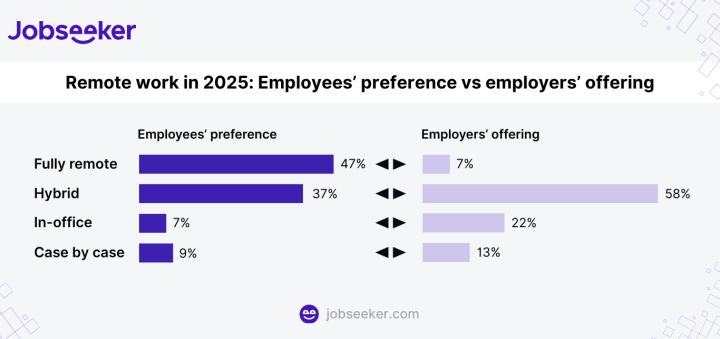
Jobseeker’s survey data indicates that employee expectations and employer offers around job flexibility is one of the most significant workplace mismatches in the US today:
- Almost half of employees would prefer fully remote working in their job (47%), but less than 1 in 10 employers are currently offering this (7%).
- Employers favor a hybrid approach, combining remote work with some office-based hours. More than half of employers currently offer this (58%).
- However, less than 4 in 10 workers cite hybrid work as their favored workplace arrangement (37%).
- Fewer than a quarter of employers believe ‘in-office only’ to be the best approach to modern employment, but even this is wildly different from employee expectations, with just 7% of employees preferring to be exclusively office-based.
- 36% of employees believe flexible working opportunities are crucial for promoting an equal work environment for all genders.
The preference for fully remote work varies according to age and seniority, though perhaps surprisingly, the trend is inverse: remote-only preference increases with seniority, but decreases with age, with the most senior AND the youngest age groups favoring remote-only opportunities the most.
While the pandemic’s initial large-scale switch to remote work shifted the dial of employee expectations, employers have recently started to assume greater control over flexible working policies. Indeed, Forbes reports a growing number of employers are creating fixed demands for the amount of time employees are expected in the office, and that number is increasing. In the six months to the end of 2024, the average number of days US employers were requiring workers to be in the office per week increased by 0.29 days (2).
AI and Automation: Job Creator or Job Destroyer?
One of the most seismic shifts in working culture in recent years is the emergence of Artificial Intelligence (AI) as a viable workplace tool. However, initial scare stories about AI taking your job seem to have dissipated, with employees now seeing the opportunities it presents, more than the threats it poses:
- Almost half of employees feel AI could increase job opportunities in the years ahead (48%).
- Around 1 in 4 employees and employers believe AI will lead to a reduction in jobs.
- Employees are far less likely to believe AI will have no impact on job opportunities, compared to employers (14% vs. 31%).
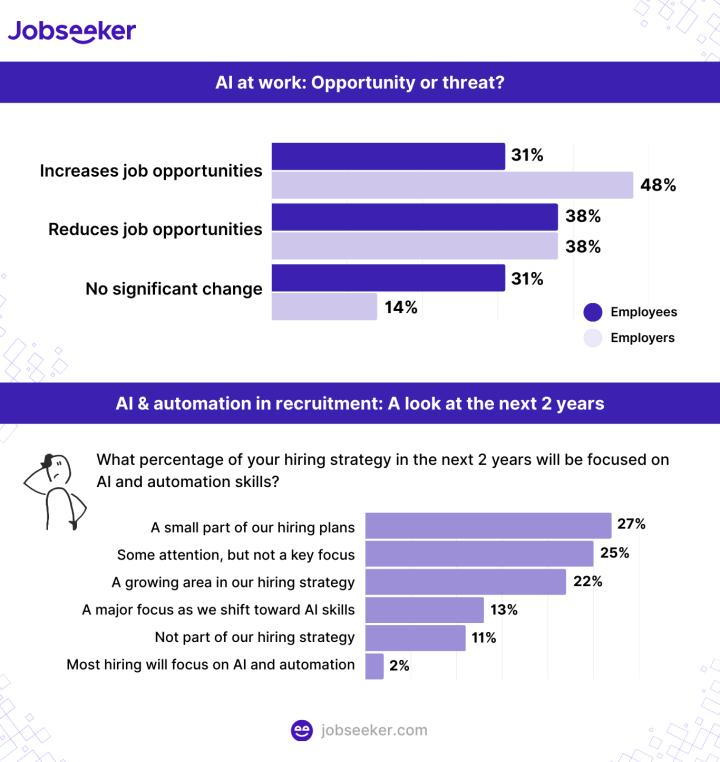
Jobseeker’s findings suggest employees may be over-indexing the significance of AI, and the necessity to upskill in this area:
- Two-thirds of employees (65%) believe they need to learn how to integrate AI into their work.
- However, only 15% of employers are making AI a ‘major focus’ or a ‘top priority’ for their hiring strategy in the next two years. Just over half (52%) are looking at it, but not making it a major priority.
- Younger employees feel far more pressured to develop AI skills (71% of 18-27 year olds and 76% of 28-43 year olds, compared to just 33% of over-60s).
Salary Transparency and Compensation Trends
For employees, a clear sense of career progression and direction is often a key contributor to job satisfaction. A total of 40% of employees mentioned opportunities for career advancement as a key element they look for in a job. Salary transparency plays an important role in employees’ understanding of their standing and progression:
- 47% of employees believe standardized salary bands would improve workplace gender equity in hiring and promotions. (3)
- Almost 4 in 10 workers (38%) believe transparent salary discussions would reduce the gender pay gap.
- Around half of employers (49%) provide full salary transparency, publishing pay ranges for all roles.
- Only 20% of employers keep their salary information completely private.
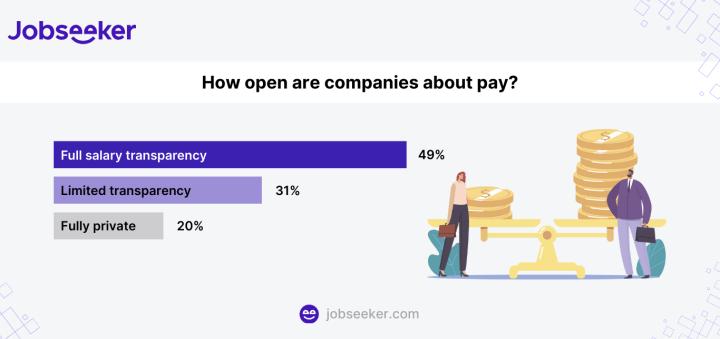
For the 20% of organizations who don’t publish any salary information, employee satisfaction could be harmed. Employers may point to potential internal conflict, increased wage bills and the cost of educating employees about wage bands as reasons against full transparency. However, failing to engage on this matter potentially leads to greater risk of staff disengagement and a reduction in retention rates.
To bridge the gap between employee expectations and employer offerings, organizations should ensure compliance with labor laws, including proper employee classification and adherence to wage regulations. Conducting regular internal pay audits can help you identify and correct disparities while demonstrating a commitment to fair pay. (4)
Why Employees Leave: The Top Workplace Dealbreakers in 2025
Jobseeker’s employee research revealed that almost two-thirds (62%) of US workers were planning to change jobs. When asked for their main reasons, the top answers were:
- Better salary and benefits
- Job security
- More growth opportunities
- A better work environment
When asking employers for the top three reasons for their workers leaving, half believe it’s down to a desire to change careers or industry. Some other key reasons include:
- Low salary or better pay elsewhere: 43%
- Relocation or personal reasons: 40%
- Better benefits offered by competitors: 39%
- Lack of career growth opportunities: 25%
- Poor work-life balance: 24%
- Toxic work culture or bad management: 23%
- Job instability or layoffs: 18%
- Limited or no remote work options: 17%
- Lack of recognition or appreciation: 13%
With two of the top three reasons cited by employers relating to compensation, and the other reflecting a change in the personal lives of employees, aspects related to workplace culture appear to be overlooked. Workers cited job security, career growth opportunities, and a healthy work environment among their top four reasons for a job change, while these reasons are all outside the top three given by employers.

The disconnect between why employees wish to change jobs and employers’ understanding could be one of the reasons so many workers feel the need to leave their current employer. This lack of employer appreciation for the importance of cultural aspects of the workplace experience could have lasting, damaging effects on worker morale and staff turnover.
Solutions: Bridging the Employer-Employee Divide
Mismatched expectations between employees and employers is a recipe for a dissatisfied, unengaged workforce, and growing skepticism from employees towards their employers and the promises they make. If left unaddressed, these mismatches risk creating an unhealthy corporate culture, reducing productivity rates and ultimately increasing staff turnover and all its associated logistical challenges and financial costs.
Aligning workplace policies with worker priorities can significantly increase the engagement and job satisfaction of employees, leading to a more productive, harmonious workplace. Here are some actionable tips for bridging the employer-employee divide:
- Publish salary banding and provide clear promotion pathways: A clear, transparent pathway for career progression is one of the key ways to keep employees motivated. Publishing salary banding, encouraging open salary discussions between workers and management, and outlining a clear, structured progression pathway for employees to move to more senior roles can all demystify the path to promotion and help promote gender pay equality.
- Embrace flexible working arrangements: Employee demands for flexible working patterns aren’t likely to subside soon, with flexible working and work-life balance both high on the list of employee job satisfaction factors. Consider introducing a structured, defined flexible working policy, according to the needs of your company, to help attract and retain the best talent.
- Prioritize AI upskilling for your workforce: AI skills are high on the list of priorities for employees. They can help employees manage their workload and become more efficient. But they can also help your company become more productive and prepared for the challenges of modern business. Designing a clear strategy for developing AI skills in your workforce offers benefits to all parties.
- Invest in improving workplace culture: The disconnect between employees' reasons for changing jobs and employers' understanding of why staff leave shows that employers often underestimate the impact of workplace culture on job satisfaction. Reassessing your core company values, investing in DEI programs, recognizing employee achievement, and investing in people-first leadership can all help to realign your company culture to meet employee expectations.
Conclusion – The Future of Work: Adapting to Meet Employee Needs
Addressing the mismatches between employee expectations and employer offers is one of the key challenges facing businesses today. Employee demands for flexible working, contrasting with employers tightening hybrid and remote working policies, are indicative that, if anything, the divide is currently growing. Taking meaningful steps to address this mismatch could improve employee engagement and company productivity. This, in turn, can create a significant commercial advantage over competitors who fail to adapt. The recent rapid evolution of workplaces is only set to continue, and it’s up to employers to decide whether to take advantage of the opportunities it presents.
Sources:



